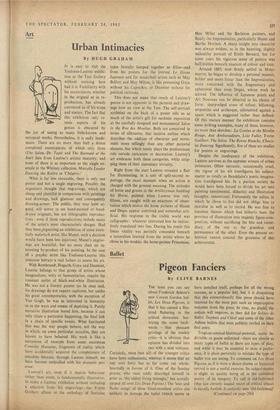Ballet
Pigeon Fanciers
By CLIVE BARNES have installed itself, perhaps for all the wrong reasons, as a popular hit), but it is disquieting that this extraordinarily fine piece should have received for the most part such an imperceptive welcome from the press. In time, no doubt, the notices will improve, as they did for Scenes de Ballet, Daphnis and Chloe and some of the other Ashton ballets that were publicly reviled on their first entry.
Tragical-comical-historical-pastoral, scene in- divisible or poem unlimited--there are almost as many types of ballet as there are types of play, and while it may be essential to state a prefer- ence, it is plain perversity to mistake the type of ballet you arc seeing. To comment on Les Deux Pigeons as if it were a dance-drama or historical revival is not a useful exercise. Its subject-matter is slight, its quality being all in the unlimited poetry of its imagery. To call it old-fashioned (that last cleverly loaded resort of critical abuse) is equally foolish. It certainly uses 'old-fashioned'
(Continued on page 260)
music, but then Britten's opera A Midsummer Night's Dream uses an 'old-fashioned' play and no one has suggested, or could suggest, that the result is anything other than modern.
I am not suggesting that Messager's music is a masterpiece. Far from it. Musically this tritely attractive score, composed in 1886, is hardly more than Delibes-with-lemonade. The relent- lessly sweet murmuring is an unpromising basis for choreography, except in its danceability, and Ashton, helped by his musical director John Lanchbery, has made a remarkable best out of a very indifferent job. Nevertheless don't go to Les Deux Pigeons just to listen to the band, for the work is a breathing refutation of the old mis- conception that ballet need be an amalgamation of choreography, music, design and drama mixing on equal terms. The choreography and the dramatic element must be top dogs, and in Les Deux Pigeons they exert an almost con- temptuous authority. This is not to say it would not be an even better ballet with a better score, but not nearly so much better as the fiercest advo- cates of ballet music's importance would like to pretend.
Ashton's devious inspiration having been fired by the nineteenth-century French ballet, he promptly, and sensibly, forgot all the details of the plot—if indeed he ever knew them. He has changed the scene from Thessaly (or was it Sicily?) and placed it, with the help of Jacques Dupont's imaginative designs, in the Paris of Murger's Vie de Boherne. His eponymous hero and heroine arc transformed—none too seriously —into a painter and his model, although he has retained a caravan load of gipsies from the first version. The story has been fined down to a boy and girl in love, the boy running off with a gipsy girl, his disillusionment and his subsequent recon- ciliation with his mistress. Reduced as it is to its abstracted essentials, this theme based on the this, and shouted it loud and clear. original La Fontaine fable may sound cosily sentimental, but the genuine tenderness and humour of the choreography give it a rich humanity that is quite timeless.
Youthful tenderness, however, is only one strand in Ashton's incredibly rich fabric, and the most remarkable thing in the ballet is its un- ceasing flow of choreographic invention. For the male dancers—who take the more prominent part in the ballet—Ashton has effortlessly produced long passages of virtuoso choreography, tough and vigorous. that exploit to the full the new virility and technical efficiency of the Royal Ballet's men. Ashton, who works with dancers as e painter works with colours, has here obviously found a fresh vein of inspiration with magnificent and far-reaching results. Something of the same wholehearted vitality appears in the ensembles for the women, and each clement adds its voice to the contrapuntal dances. Equally fascinating is his work for the three principals, all with their characters emerging from the choreography itself, yet blending into the total impression.
The ballet has been created for what has by tradition been known as the Royal Ballet's second company--by tradition yet no longer in fact, for with this work they have arrived, and the term 'second company' must now be taken more as a convenient label than as a description. Christopher Gable in the leading role of the young man brings a Bolshoi assurance to all his dancing and, even more strikingly, his acting. The- love-kitten Lynn Seymour, essentially feminine in all moods from the pert to the ardent, and Elizabeth Ander- ton, brilliantly dusky as the Gipsy, both display fully qualities they have previously only hinted at. In lesser roles Robert Mead and Johaat Mosaval dance like demons, as indeed does the whole company. It is that kind of ballet, and I am only surprised that everybody has not realised







































 Previous page
Previous page